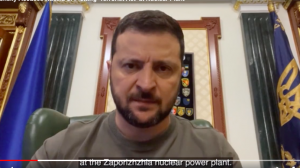Russia and Ukraine edge toward a radiologic abyss
ø
Ukrainian President Zelenskyy has demonstrated Churchill-ian and Reagan-esque leadership qualities since the Russian invasion in 2022. I’ll have more to say about this down the road, but it has been a long time since we’ve seen an essential quality of leadership — the ability to act like a leader — so aptly demonstrated on the world stage.
But one must always remember that truth is often the first casualty of conflict. Both the Ukrainians and Russians know the power of propaganda, and they both exploit it.
Don’t read my caution in this regard as a lessening of my support for Ukraine in this particular conflict. My support is unequivocal, but that does not mean that information from the conflict needs simply swallowed before being well chewed. We know Russia’s RT is a propaganda machine, but I’ve also seen many Western media reports over the past year that uncritically devolve to simple cheer-leading for Ukraine that could also end in disaster for Ukraine.
Dating to the Soviet era, Russian use of propaganda, disinformation, and misinformation is both reflex and operational norm. Moreover, anyone who thinks his own country does not engage in such activities is, at best, profoundly naive. Especially early on, Zelenskyy and the Ukrainian leadership were desperate (and they still face long odds). In such, circumstances it is important for a leader to be out ahead of the news.
 With such cautions noted, President Zelenskyy yesterday warned via Twitter that “We have just had a report from our intelligence and the Security Service of
With such cautions noted, President Zelenskyy yesterday warned via Twitter that “We have just had a report from our intelligence and the Security Service of As President Zelenskyy aptly went on to aptly note, radiologic contamination observes no international borders.
Not all nuclear contamination and/or leaks, however, must be explosively Chernobyl-like with broad atmospheric dispersion. Parties with the intent of committing nuclear terrorism can also create damage that disables nuclear power plants and primarily contaminates surrounding soils and water tables. Such sabotage could also prove debilitating to military operations in the region.
It is also important to note that while the Russian have occupied and controlled the Zaporizhzhia nuclear power plant (the largest in Europe), there are other nuclear power plant targets of opportunity in Western Ukraine.
The Zaporizhzhia nuclear power plant has six reactors. the breach of the Nova Kakhovka dam downstream from the facility in May lowered reservoir levels of water used to cool the plant, but experts predict the facility retains months of cooling water reserves
In the west, the Khmelnytskyi nuclear power plant has two existing operating reactors with two unfueled reactors under construction. In November 2022, it was knocked off the grid following missile strike sin the region. Rivne nuclear power plant has four operating reactors. South Ukraine nuclear power plant has three reactor and has three times since the Russian invasion sustained damage. It was twice disconnected from the grid in 2022 following nearby shelling and missile strikes.
After its invasion of Ukraine in February 2022, Russian forces occupied the damaged Chernobyl nuclear power plant and external
power supplied to the plant was disrupted. Ukraine claims the site’s analytical laboratories for radiation monitoring were destroyed and analytical instruments were stolen before Russian forces transferred control of Chernobyl back to Ukrainian personnel at the end of March 2022. At Chernobyl, Unit 1 is still in the decommissioning process. Units 2 and 3 were respectively closed in March 1999 and December 2000. The Unit 4, reactor that exploded in 1986 is protected by the sarcophagus built over the reactor following the accident and the New Safe Confinement dome moved over the sarcophagus in 2016 into position in 2016. Units 5 and 6 at Chernobyl were never finished.
Chernobyl also houses the Central Spent Fuel Storage Facility (CSFSF), a dry storage site for used nuclear fuel assemblies from the reactors at Khmelnytskyi, Rivne and South Ukraine nuclear power plants.
The Kharkov Institute of Physics and Technology housed an experimental nuclear reactor used for research that was shut down (placed in a deep subcritical state) immediately following the Russian invasion. The facility was used to produce radioactive isotopes for medical and industrial use was heavily damaged by shelling during fighting around the plant, but no radiotin leaks have, as of 23 June 2023 have been detected.
In February 2022 news reports that the State Interregional Specialized Plants for Radioactive Waste Management (SISP) of UkrDO Radon in Kyiv was damaged by a missile proved unwarranted. The SISPs are used to store used to store radioactively contaminated materials used in industry, medicine and scientific research. No radiation leaks have subsequently been detected.
Nuclear power stations at Chyhyryn, and in Odessa and Russian-annexed Crimea were never made operational.
The electricity grid of Ukraine was successfully synchronized with the Continental European Grid in March 2022.
Photo: Twitter Screenshot (c) K. Lee Lerner / LMG
- previous:
- Wave-particle duality
- next:
- Russia: Wagner Group insurrection (updated)


